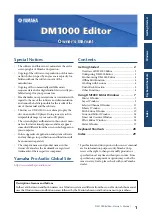
ETERNUS Disk storage systems ETERNUSmgr User Guide -Introduction-
52
Copyright 2009 FUJITSU LIMITED
P2X0-0202-04ENZ0
Chapter 6
Messages
This chapter explains the messages and message files of ETERNUSmgr.
Messages are categorized into the following types:
•
Alarm History Messages
•
Alarm Text Files
•
E-mail Messages
•
Log Messages
6.1
Alarm History Messages
This section explains the alarm history messages generated by ETERNUSmgr.
If, after ETERNUSmgr polls a target device, the current status of the target device differs from
the status at the previous polling operation (i.e. the status of the target device has changed), an
ETERNUSmgr alarm history message is issued and saved in an alarm history file. If
ETERNUSmgr detects that the target device is offline, an alarm history file is not created.
The alarm history file is saved using the following file naming convention in the directory
specified in the setup file. See
"Alarm History File Directory" (page 24)
for more information
about the setup files.
YYYY
: Year
MM
: Month
DD
: Day
HH
: Hour
mm
: Minute
SS
: Second
n
: Sequence number
For example, the alarm history file "200812011020300.htm" was created on December 1st 2008
at 10:20:30.
The sequence number is normally 0, but is used to number files sequentially if multiple files are
created within the same second.
An alarm history file is created when a change in the target device status is detected while
ETERNUSmgr is polling the target device. Alarm history files are automatically deleted when
they are older than the limit specified in the setup file. See
"Number of Days Alarm History Files
are Kept" (page 26)
for more information about the setup files.
Alarm history files are in HTML format for viewing in a Web browser.
Alarm history files are displayed as follows in the Web browser.
YYYYMMDDHHmmSSn.html













































